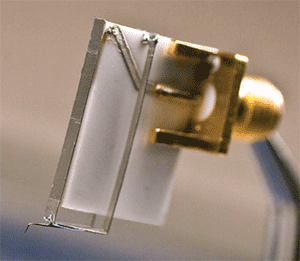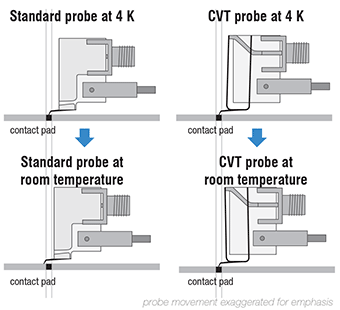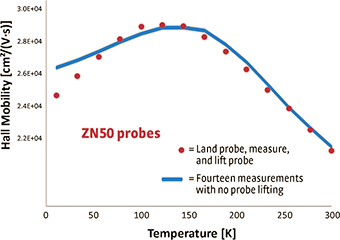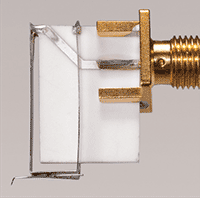Adjusting for probe travel while making measurements easier With probe arms thermally anchored to the sample stage, a standard probe tip may move as much as 400 µm as the sample stage warms from 4.2 K to room temperature. This prevents you from making automated
variable temperature measurements, as probes have to be lifted and re-landed for any significant temperature transition. With probe arms thermally anchored to the sample stage, a standard probe tip may move as much as 400 µm as the sample stage warms from 4.2 K to room temperature. This prevents you from making automated
variable temperature measurements, as probes have to be lifted and re-landed for any significant temperature transition.
Stable tip position Lake Shore’s patented CVT (continuously variable temperature) probe design absorbs probe arm movement caused by thermal expansion and contraction. The result is
a stable probe tip landing position throughout variable temperature cycling. Continuous measurements CVT probes allow you to perform continuous variable temperature measurements, which means faster and more automated experiments. You spend less time adjusting probe positions
and more time conducting research. Retrofittable onto existing platforms, CVT probes enhance the overall functionality of your Lake Shore probe station by making many of your measurements easier and more convenient
to perform, as well as enabling new measurement applications. |
Increased efficiency plus new measurement typesFast and convenient The ZN50R-CVT probes allow you to take continuously variable temperature measurements without lifting and repositioning your probes each time you make changes to sample stage
temperature. Configure your measurement, program the sample stage temperature rate of change in your temperature controller, and go. Increase measurement functionality In addition to improved efficiency and faster results, measurement uncertainty is greatly reduced by eliminating the variability of repeated contact landings.
Even experienced users with good technique cannot totally eliminate contact resistance variation on every probe landing. Measurements including Hall effect, gated Hall, IV, AHE, MR, DLTS, CV, photoluminescence and Seebeck
effect are much easier and more convenient to perform.  In a comparison between standard ZN50R probes and the new CVT probes, you can see that the standard probes would need to be repositioned before the arms expand enough to move them off the landing position. The CVT probes flex and maintain contact with the desired location. | Patented CVT tip measurement resultsThe figure below demonstrates the real-world measurement performance of the ZN50R-CVT probes. Hall mobility versus temperature was derived, comparing the ZN50R-CVT probes to Lake Shore standard ZN50R probes. Measurements
were taken on a Lake Shore Model CPX-VF vertical field probe station. The ZN50R probes were lifted during temperature changes and re-landed once the temperature settled, requiring fourteen different operator interventions.
The ZN50R-CVT probes were landed at 20 K and left on the sample through the temperature range of 20 K to 300 K with no operator intervention. For both experiments, temperature was ramped in point-by-point
mode: the setpoint was changed, temperature allowed to settle, and measurements were taken.  With patented ZN50R-CVT probes you don’t have to constantly lift and re-land during measurements |
 Developed in collaboration with TOYO Corporation of Japan, the Lake Shore patented Model ZN50R-CVT automatically compensates for probe arm temperature expansion of thermally anchored probes, significantly improving measurement reliability
and enabling measurement automation over wide temperature ranges.
Developed in collaboration with TOYO Corporation of Japan, the Lake Shore patented Model ZN50R-CVT automatically compensates for probe arm temperature expansion of thermally anchored probes, significantly improving measurement reliability
and enabling measurement automation over wide temperature ranges.

 With probe arms thermally anchored to the sample stage, a standard probe tip may move as much as 400 µm as the sample stage warms from 4.2 K to room temperature. This prevents you from making automated
variable temperature measurements, as probes have to be lifted and re-landed for any significant temperature transition.
With probe arms thermally anchored to the sample stage, a standard probe tip may move as much as 400 µm as the sample stage warms from 4.2 K to room temperature. This prevents you from making automated
variable temperature measurements, as probes have to be lifted and re-landed for any significant temperature transition.





